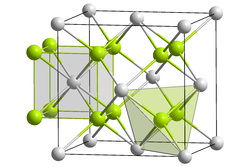Nickel disilicide
| Crystal structure | |||||||||||||
|---|---|---|---|---|---|---|---|---|---|---|---|---|---|

|
|||||||||||||
| __ Ni __ Si | |||||||||||||
| General | |||||||||||||
| Surname | Nickel disilicide | ||||||||||||
| Ratio formula | NiSi 2 | ||||||||||||
| Brief description |
gray-blue solid |
||||||||||||
| External identifiers / databases | |||||||||||||
|
|||||||||||||
| properties | |||||||||||||
| Molar mass | 114.86 g mol −1 | ||||||||||||
| Physical state |
firmly |
||||||||||||
| density |
4.83 g cm −3 |
||||||||||||
| Melting point |
1200 ° C |
||||||||||||
| safety instructions | |||||||||||||
|
|||||||||||||
| As far as possible and customary, SI units are used. Unless otherwise noted, the data given apply to standard conditions . | |||||||||||||
Nickel disilicide is an inorganic chemical compound of nickel from the group of silicides .
Extraction and presentation
Nickel disilicide can be obtained by reacting nickel with silicon at 750 ° C.
properties
Nickel disilicide is a gray-blue solid. It is a semiconductor and has a crystal structure of the fluorite type with the space group Fm 3 m (space group No. 225) . The connection has a resistance of about 34 to 50 µΩ / cm.
use

Nickel disilicide is used as a contact material in the semiconductor industry. The lattice spacing of the connection is only 0.4% smaller than that of silicon.
Related links
In addition to nickel disilicide, at least five other nickel silicides stable at room temperature are known: Ni 3 Si, Ni 31 Si 12 , Ni 3 Si 2 , NiSi and dinickel silicide (Ni 2 Si). The phase diagram shows a total of eleven nickel silicides.
Individual evidence
- ↑ a b scielo.org.za: Aspects of colored precious metal intermetallic compounds ( Memento of the original from July 7, 2016 in the Internet Archive ) Info: The archive link was inserted automatically and has not yet been checked. Please check the original and archive link according to the instructions and then remove this notice. , accessed July 7, 2016
- ^ A b Open Publications of UTS Scholars, Supansomboon, S: Properties and applications of metastable precious metal intermetallic compounds , accessed July 7, 2016
- ↑ a b Entry on nickel disilicide in the GESTIS substance database of the IFA , accessed on July 23, 2016(JavaScript required) .
- ^ A b Dale L. Perry: Handbook of Inorganic Compounds . CRC Press, 1995, ISBN 978-0-8493-8671-8 , pp. 13 ( limited preview in Google Book search).
- ↑ BA Julie, D. Knoesen, R. Pretorius, D. Adams: A study of the NiSi to NiSi2 transition in the NiSi binary system. In: Thin Solid Films. 347, 1999, p. 201, doi : 10.1016 / S0040-6090 (99) 00004-8 .
- ↑ Jane E. Macintyre: Dictionary of Inorganic Compounds . CRC Press, 1992, ISBN 978-0-412-30120-9 , pp. 3669 ( limited preview in Google Book Search).
- ^ A b Yoshio Nishi, Robert Doering: Handbook of Semiconductor Manufacturing Technology, Second Edition . CRC Press, 2007, ISBN 978-1-4200-1766-3 , pp. 18 ( limited preview in Google Book search).
- ^ Johann-Friedrich Luy, Peter Russer: Silicon-Based Millimeter-Wave Devices . Springer Science & Business Media, 2013, ISBN 978-3-642-79031-7 , pp. 74 ( limited preview in Google Book search).
- ^ Inder P. Batra: Metallization and Metal-Semiconductor Interfaces . Springer Science & Business Media, 2012, ISBN 978-1-4613-0795-2 , pp. 216 ( limited preview in Google Book search).
- ^ William M. Haynes: CRC Handbook of Chemistry and Physics, 94th Edition . CRC Press, 2016, ISBN 978-1-4665-7115-0 , pp. 77 ( limited preview in Google Book search).



